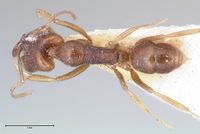Anochetus ruginotus
| Anochetus ruginotus | |
|---|---|

| |
| Scientific classification | |
| Kingdom: | Animalia |
| Phylum: | Arthropoda |
| Class: | Insecta |
| Order: | Hymenoptera |
| Family: | Formicidae |
| Subfamily: | Ponerinae |
| Tribe: | Ponerini |
| Genus: | Anochetus |
| Species: | A. ruginotus |
| Binomial name | |
| Anochetus ruginotus Stitz, 1925 | |
Identification
Zettel (2012) - TL 4.3 - 4.6 mm; Head stout, posteriorly weakly constricted, vertex deeply emarginate; longitudinal striation almost reaching nuchal carina. Eye small, with some minute setae. Mandible stout and short, MdI = 55; shaft medianly with two edges, dorsal one smooth, ventral one minutely serrate; intercalary tooth strongly developed. Pronotum with distinct longitudinal striation; propodeum with irregular rugosity. Petiole with narrow node in lateral aspect, its apex narrowly rounded when seen laterally, weakly convex (almost straight) in anterior aspect; peduncle almost absent. Gaster tergite 1 sparsely punctured. Whole dorsum with densely set, short setae, head with additional subcumbent pilosity.
Anochetus ruginotus was described from “Luzon” (Stitz 1925); the exact type locality remains unknown. A new record from northeastern Mindanao indicates a wide distribution in the archipelago. The species was set in synonymy with A. graeffei by Brown (1978). However, morphological evidence is strong that A. ruginotus is a valid species, and the two species can be easily distinguished by the characters presented in the key (couplet 5). Anochetus graeffei has a wide distribution and is also present in the Philippines. At a first glance A. ruginotus and A. graeffei have a very different habitus. While in A. graeffei the head is squared and the mesosoma is broad, A. ruginotus has a deep emargination of the vertex and the mesosoma is slender as in most other Anochetus species. Body size, ratio of PW / HW and sculpture of gaster tergite 1 (see the key) differ conspicuously when comparing Philippine specimens of the two taxa. However body size ranges are overlapping when including all populations of A. graeffei s.l. The entire mandible, but most notably its apical teeth are usually more gracile in A. graeffei than in A. ruginotus, except for the syntypes of A. rudis, which have stout mandibles, almost as A. ruginotus. An additional difference between A. ruginotus and A. graeffei is found in head sculpture. Although strong variation is observed in the extension of the striation in A. graeffei, in all forms a strong puncturation is intermitting the striae, so that in densely sculptured specimens the intervals appear interrupted. In contrast setiferous punctures in A. ruginotus are very fine and hardly “disturbing” a regular striation. A difference in the apex of the petiolar node, which is rounded in A. ruginotus and incised in some Philippine A. graeffei specimens, is not consistent in A. graeffei s.l.
Keys including this Species
Distribution
Distribution based on Regional Taxon Lists
Indo-Australian Region: Philippines (type locality).
Distribution based on AntMaps
Distribution based on AntWeb specimens
Check data from AntWeb
Countries Occupied
| Number of countries occupied by this species based on AntWiki Regional Taxon Lists. In general, fewer countries occupied indicates a narrower range, while more countries indicates a more widespread species. |

|
Estimated Abundance
| Relative abundance based on number of AntMaps records per species (this species within the purple bar). Fewer records (to the left) indicates a less abundant/encountered species while more records (to the right) indicates more abundant/encountered species. |

|
Biology
Castes

| |
| . | |
Nomenclature
The following information is derived from Barry Bolton's Online Catalogue of the Ants of the World.
- ruginotus. Anochetus ruginotus Stitz, 1925: 114 (w.) PHILIPPINES (Luzon).
- Type-material: holotype worker.
- Type-locality: Philippines: Luzon (Jagor).
- Type-depository: MNHU.
- [Misspelled as ruginotis by Chapman & Capco, 1951: 41, Tiwari, 1999: 20.]
- Junior synonym of graeffei: Brown, 1978c: 557; Bolton, 1995b: 65; Zhou, 2001b: 30; Shattuck & Slipinska, 2012: 11.
- Status as species: Chapman & Capco, 1951: 41; Baltazar, 1966: 238; Tiwari, 1999: 20; Zettel, 2012: 164 (redescription).
- Distribution: Philippines (Luzon, Mindanao).
Unless otherwise noted the text for the remainder of this section is reported from the publication that includes the original description.
Description
Worker
Zettel (2012) - Holotype: TL 4.58; HL 1.20; HW 1.05; CI 88; MdL 0.69; MdI 58; SL 0.96; SI 91; MsL 1.38; PnW 0.56; PtH 0.44; PtL 0.45; PtW 0.24.
References
- Brown, W. L., Jr. 1978c. Contributions toward a reclassification of the Formicidae. Part VI. Ponerinae, tribe Ponerini, subtribe Odontomachiti. Section B. Genus Anochetus and bibliography. Stud. Entomol. 20: 549-638 (page 557, junior synonym of graeffei)
- Stitz, H. 1925c. Ameisen von den Philippinen, den malayischen und ozeanischen Inseln. Sitzungsber. Ges. Naturforsch. Freunde Berl. 1923: 110-136 (page 114, worker described)
- Zettel, H. 2012. New trap-jaw ant species of Anochetus MAYR, 1861 (Hymenoptera: Formicidae) from the Philippine Islands, a key and notes on other species. Myrmecological News 16: 157-167.

